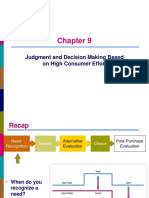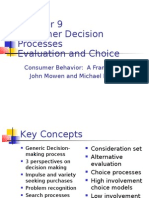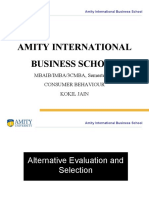Consumer Decision-Making: Srabantimukherjee
Consumer Decision-Making: Srabantimukherjee
Uploaded by
Harshit KediaCopyright:
Available Formats
Consumer Decision-Making: Srabantimukherjee
Consumer Decision-Making: Srabantimukherjee
Uploaded by
Harshit KediaOriginal Title
Copyright
Available Formats
Share this document
Did you find this document useful?
Is this content inappropriate?
Copyright:
Available Formats
Consumer Decision-Making: Srabantimukherjee
Consumer Decision-Making: Srabantimukherjee
Uploaded by
Harshit KediaCopyright:
Available Formats
Consumer
Decision-Making
SRABANTI MUKHERJEE
© Cengage Learning India Pvt. Ltd.
Chapter Goals
After completing this chapter, you will be able to
understand :
The consumer black-box model
Problem recognition process of consumer
How marketers can utilize the information search process
How consumers evaluate their choice alternatives
Consumers’ purchase situations
Post-purchase behaviour and dissonance patterns of the
consumers
Distinction between low- and high-involvement buying
decisions
© Cengage Learning India Pvt. Ltd.
Types of Consumer Buying Decisions
Routine response/habitual buying behaviour: This kind of purchase situation refers
to the low involvement in often-purchased low-priced products.
Limited problem-solving behaviour: A limited problem-solving behaviour
encompasses more involvement and effort of the buyer than the routine response
behaviour. More specifically, when the product class is known, but the customer is
not very sure about the newly launched brand attributes, the limited problem-
solving behaviour is quite visible.
Extensive decision-making/complex buying behaviour: The complex buying
decision involves the high involvement, unfamiliar, expensive, and/or infrequently
bought purchases. This kind of purchasing is normally associated with a high degree
of economic, performance-related, or even psychological risk.
Impulse buying, no conscious planning : According to the American marketing
association, an impulse buying is ‘a purchase behaviour that is assumed to be made
without prior planning or thought. Often, it is claimed, impulse buying involves an
emotional reaction to the stimulus object (product, packaging, point-of-purchase
display, or whatever) which leads to instant purchase decision
© Cengage Learning India Pvt. Ltd.
The Consumer Decision-Making Model (The
Consumer Black Box Model; Kotler, 1990)
© Cengage Learning India Pvt. Ltd.
The Stimuli Influencing Buyer Behaviour
Marketing Mix Factors (Product, Price,
Place, Promotion)
Demographic Factors
Economic factors,
Situational factors
Social Parameters
© Cengage Learning India Pvt. Ltd.
Transformation—The Black Box Under Process
In the black-box model, there are two key constructs,
namely, the customer’s internal influences and his
five-stage decision-making process.
Internal Influencing Factors of Consumer
Decision Making
Perceptions
Attitude
Lifestyle factor
Motivation
Personality
© Cengage Learning India Pvt. Ltd.
The Five-Stage Buying Decision Process
© Cengage Learning India Pvt. Ltd.
Need Recognition
© Cengage Learning India Pvt. Ltd.
Information Search
Internal Search
External Search
© Cengage Learning India Pvt. Ltd.
Evaluation of Alternatives
For the evaluation of the available alternatives, however, three basic aspects are to be
taken care of by consumers. They are as follows:
(a) The evoked set: The evoked set is often referred as the list of brands or sometimes
models of a particular brand, from which the customer is likely to choose the best
suited one for him/her.
(b) Evaluative criteria: Evaluative criteria are those characteristics of the product
which are used by customers to select a brand (from the evoked set), which suits
them the best. These criteria may be price, availability, style, design, brand
equity, etc.
(c) Decision rules/heuristics: Once the evoked set of brands or models are identified
and the evaluative criteria are recognized according to their relative importance,
consumers exert to their relevant decision rules or heuristics to select the best
suited one. There are two broad categories of decision rules, namely, the
compensatory and non-compensatory decision rules
© Cengage Learning India Pvt. Ltd.
Compensatory Decision Rules
In the compensatory
decision rule, first
consumers assign weight to
several evaluative criteria.
Then they evaluate a brand
or model in terms of the
relevant evaluative criteria,
and a weighted sum for
each alternative is,
thereafter, calculated.
© Cengage Learning India Pvt. Ltd.
Non-compensatory decision rules
Sometimes, the consumers cannot balance the
negative features of a brand with some positive aspects
in case of non-compensatory decision rules.
There are three major non-compensatory rules:
Conjunctive rule
Disjunctive rule
Lexicographic rule.
© Cengage Learning India Pvt. Ltd.
Non-compensatory decision rules
Conjunctive Decision Rule
In the conjunctive decision
rule, consumers establish a
minimum point of cutoff for
each attribute. If any brand
falls below the cutoff point in
terms of the selected
attributes, it is eliminated
from the choice set. In case
of Mr. Umesh Nair, if he sets
a cutoff point of 3 for all the
choice attributes, then we
find, except Maruti Alto Std,
all other cars have scores
below 3 in some attributes.
Hence, Maruti Alto would be
chosen by Mr. Nair, if he
follows the conjunctive
decision rule.
© Cengage Learning India Pvt. Ltd.
Non-compensatory decision rules
The Disjunctive Rule
The disjunctive rule, is just
the reverse of the
conjunctive rule. Similar to
the conjunctive decision-
making rule, here also a
minimum cutoff level for
each attribute is set.
According to this rule, Mr.
Nair will choose the
alternative which may satisfy
his minimum cutoff in terms
of any choice criteria.
Usually, this cutoff is set
little above the cutoff value
set in conjunctive rule. In
this case, let us assume the
cut-off is 4.
© Cengage Learning India Pvt. Ltd.
The limitations of conjunctive and disjunctive
rules
As all the brands are meeting the cutoff, all of them
still remain in the evoked set.
Therefore, consumers once again need to resort to
some other decision rule to arrive at a choice of their
most preferred brand/model.
Both conjunctive and disjunctive heuristics suffer
from the problem of less sophistication.
© Cengage Learning India Pvt. Ltd.
The solution- Lexicographic Heuristics
In case of lexicographic heuristics, consumers first order the
attributes according to their perceived importance.
For example, in the said example of Mr. Nair, according to his relative
importance, the evaluative criteria can be ranked as price (1st), fuel
efficiency (2nd), warranty period (3rd), dealer’s proximity (4th), bank
loan (5th), and wife’s choice (6th).
Now, consumers compare all the brands’ score in terms of the most
important criteria set by them in single/multiple iterations till the
most preferred alternative is identified.
Here, Mr. Nair has selected price as the most important attribute.
Now Tata Nano Std BSIII scores the highest (5) as compared to the
other brands in terms of price criteria and hence would be considered
as the best-suited alternative for Mr. Nair.
© Cengage Learning India Pvt. Ltd.
The solution- Lexicographic Heuristics
© Cengage Learning India Pvt. Ltd.
After Referral Decision Rules
In many cases, these basic rules are mixed to derive a
new choice rule, like if there are too many brands in
the evoked set, then conjunctive–compensatory or
disjunctive–lexicographic may appear to be
appropriate.
This type of combined choice heuristics is called the
after-referral decision rule and this is perhaps the
most popular choice heuristics.
© Cengage Learning India Pvt. Ltd.
Responses—The Outcome of Black-Box
Processing
Product choice and purchase
Post-purchase use and evaluation
Satisfaction
Neutral state of mind
Cognitive dissonance
© Cengage Learning India Pvt. Ltd.
You might also like
- Introduction To Management - Foundation of Decision Making100% (4)Introduction To Management - Foundation of Decision Making13 pages
- Prof - Ed 233: Principles and Method of Teaching100% (1)Prof - Ed 233: Principles and Method of Teaching5 pages
- Consumer Behavior - Alternative Evaluation and Selection - Session 12 - May 16 2011100% (1)Consumer Behavior - Alternative Evaluation and Selection - Session 12 - May 16 201113 pages
- Describe the steps in the consumer decision making process for each of the following cases – a) A businessman considering the purchase of a new mobile phone for communication between branches of his firm and b) A consumer considering the purchase of a headache remedy that is advertised as stronger and more effectiveNo ratings yetDescribe the steps in the consumer decision making process for each of the following cases – a) A businessman considering the purchase of a new mobile phone for communication between branches of his firm and b) A consumer considering the purchase of a headache remedy that is advertised as stronger and more effective3 pages
- Introduction To Consumer Behavior Assignment 7 Aetazaz Ikram 19U00648No ratings yetIntroduction To Consumer Behavior Assignment 7 Aetazaz Ikram 19U006482 pages
- Consumer Decision Making and Beyond MKT 344 Lecturer NNA: Consumer Behavior, Ninth Edition Schiffman & KanukNo ratings yetConsumer Decision Making and Beyond MKT 344 Lecturer NNA: Consumer Behavior, Ninth Edition Schiffman & Kanuk42 pages
- Solomon - cb12 - Inppt - 09 Consumer BehaviorNo ratings yetSolomon - cb12 - Inppt - 09 Consumer Behavior42 pages
- Consumer Behavior and Building Marketing Strategy: Alternative Evaluation and SelectionNo ratings yetConsumer Behavior and Building Marketing Strategy: Alternative Evaluation and Selection23 pages
- Consumer Decision Rules: Compensatory NoncompensatoryNo ratings yetConsumer Decision Rules: Compensatory Noncompensatory9 pages
- Chapter 4: Consumer Decision-Making ProcessNo ratings yetChapter 4: Consumer Decision-Making Process25 pages
- Organisational Buying and Buying BehaviourNo ratings yetOrganisational Buying and Buying Behaviour17 pages
- Lecture 4 - Evaluation of Decision AlternativesNo ratings yetLecture 4 - Evaluation of Decision Alternatives28 pages
- Automotive Consumer Archetypes - India PerspectiveNo ratings yetAutomotive Consumer Archetypes - India Perspective53 pages
- CHAPTER 11 UNDERSTANDING DECISION MAKINGNo ratings yetCHAPTER 11 UNDERSTANDING DECISION MAKING16 pages
- Managerial Accounting - Decision Making: Relevant Costs & BenefitsNo ratings yetManagerial Accounting - Decision Making: Relevant Costs & Benefits8 pages
- Supplementary Slides Consumer Decision MakingNo ratings yetSupplementary Slides Consumer Decision Making53 pages
- Presentation On Evaluative Criteria and Decision RulesNo ratings yetPresentation On Evaluative Criteria and Decision Rules9 pages
- Identifying Marketsegments Andtargets: Marketing Quality CircleNo ratings yetIdentifying Marketsegments Andtargets: Marketing Quality Circle24 pages
- Amity International Business School: MBAIB/IMBA/3CMBA, Semester IV Consumer Behaviour Kokil JainNo ratings yetAmity International Business School: MBAIB/IMBA/3CMBA, Semester IV Consumer Behaviour Kokil Jain14 pages
- Types of Decisions: Asynchronous Class April 2-6, 2023-04-05 Strategic Human Resource ManagementNo ratings yetTypes of Decisions: Asynchronous Class April 2-6, 2023-04-05 Strategic Human Resource Management12 pages
- Guidance For Evaluating Financial Planning StrategiesNo ratings yetGuidance For Evaluating Financial Planning Strategies89 pages
- Teaching and Learning Unit IV Learning Theories and Characteristics of Adult LearnersNo ratings yetTeaching and Learning Unit IV Learning Theories and Characteristics of Adult Learners34 pages
- Theory: Theory Description How Will You Implement?No ratings yetTheory: Theory Description How Will You Implement?2 pages
- Unit 7 - Instructional Approaches For Activating Prior KnowledgeNo ratings yetUnit 7 - Instructional Approaches For Activating Prior Knowledge6 pages
- KMF 1023 Cognitive Psychology: Case Study (20%) - 3 Students in A GroupNo ratings yetKMF 1023 Cognitive Psychology: Case Study (20%) - 3 Students in A Group8 pages
- 423 Artificial Intelligence IndiashastraNo ratings yet423 Artificial Intelligence Indiashastra1 page
- Nanik Margaret Tarihoran - 01307170048 - Lesson Plan PSAL Art - Grade 6 - Poster (Making Poster) - DikonversiNo ratings yetNanik Margaret Tarihoran - 01307170048 - Lesson Plan PSAL Art - Grade 6 - Poster (Making Poster) - Dikonversi12 pages
- Application of Erikson Theory in ClassroomNo ratings yetApplication of Erikson Theory in Classroom7 pages
- Motivation: Motivation Is The Act of Stimulating Someone or Oneself To Get A Desired Course of ActionNo ratings yetMotivation: Motivation Is The Act of Stimulating Someone or Oneself To Get A Desired Course of Action13 pages
- Module 1 - The Child and Adolescent Learners and Learning Principles100% (1)Module 1 - The Child and Adolescent Learners and Learning Principles6 pages
- Introduction To Management - Foundation of Decision MakingIntroduction To Management - Foundation of Decision Making
- Consumer Behavior - Alternative Evaluation and Selection - Session 12 - May 16 2011Consumer Behavior - Alternative Evaluation and Selection - Session 12 - May 16 2011
- Describe the steps in the consumer decision making process for each of the following cases – a) A businessman considering the purchase of a new mobile phone for communication between branches of his firm and b) A consumer considering the purchase of a headache remedy that is advertised as stronger and more effectiveDescribe the steps in the consumer decision making process for each of the following cases – a) A businessman considering the purchase of a new mobile phone for communication between branches of his firm and b) A consumer considering the purchase of a headache remedy that is advertised as stronger and more effective
- Introduction To Consumer Behavior Assignment 7 Aetazaz Ikram 19U00648Introduction To Consumer Behavior Assignment 7 Aetazaz Ikram 19U00648
- Consumer Decision Making and Beyond MKT 344 Lecturer NNA: Consumer Behavior, Ninth Edition Schiffman & KanukConsumer Decision Making and Beyond MKT 344 Lecturer NNA: Consumer Behavior, Ninth Edition Schiffman & Kanuk
- Consumer Behavior and Building Marketing Strategy: Alternative Evaluation and SelectionConsumer Behavior and Building Marketing Strategy: Alternative Evaluation and Selection
- Consumer Decision Rules: Compensatory NoncompensatoryConsumer Decision Rules: Compensatory Noncompensatory
- Automotive Consumer Archetypes - India PerspectiveAutomotive Consumer Archetypes - India Perspective
- Managerial Accounting - Decision Making: Relevant Costs & BenefitsManagerial Accounting - Decision Making: Relevant Costs & Benefits
- Presentation On Evaluative Criteria and Decision RulesPresentation On Evaluative Criteria and Decision Rules
- Identifying Marketsegments Andtargets: Marketing Quality CircleIdentifying Marketsegments Andtargets: Marketing Quality Circle
- Amity International Business School: MBAIB/IMBA/3CMBA, Semester IV Consumer Behaviour Kokil JainAmity International Business School: MBAIB/IMBA/3CMBA, Semester IV Consumer Behaviour Kokil Jain
- Types of Decisions: Asynchronous Class April 2-6, 2023-04-05 Strategic Human Resource ManagementTypes of Decisions: Asynchronous Class April 2-6, 2023-04-05 Strategic Human Resource Management
- Guidance For Evaluating Financial Planning StrategiesGuidance For Evaluating Financial Planning Strategies
- Consumer protection The Ultimate Step-By-Step GuideFrom EverandConsumer protection The Ultimate Step-By-Step Guide
- Mobile edge computing A Clear and Concise ReferenceFrom EverandMobile edge computing A Clear and Concise Reference
- Codero Hosting The Ultimate Step-By-Step GuideFrom EverandCodero Hosting The Ultimate Step-By-Step Guide
- Teaching and Learning Unit IV Learning Theories and Characteristics of Adult LearnersTeaching and Learning Unit IV Learning Theories and Characteristics of Adult Learners
- Theory: Theory Description How Will You Implement?Theory: Theory Description How Will You Implement?
- Unit 7 - Instructional Approaches For Activating Prior KnowledgeUnit 7 - Instructional Approaches For Activating Prior Knowledge
- KMF 1023 Cognitive Psychology: Case Study (20%) - 3 Students in A GroupKMF 1023 Cognitive Psychology: Case Study (20%) - 3 Students in A Group
- Nanik Margaret Tarihoran - 01307170048 - Lesson Plan PSAL Art - Grade 6 - Poster (Making Poster) - DikonversiNanik Margaret Tarihoran - 01307170048 - Lesson Plan PSAL Art - Grade 6 - Poster (Making Poster) - Dikonversi
- Motivation: Motivation Is The Act of Stimulating Someone or Oneself To Get A Desired Course of ActionMotivation: Motivation Is The Act of Stimulating Someone or Oneself To Get A Desired Course of Action
- Module 1 - The Child and Adolescent Learners and Learning PrinciplesModule 1 - The Child and Adolescent Learners and Learning Principles

























































































